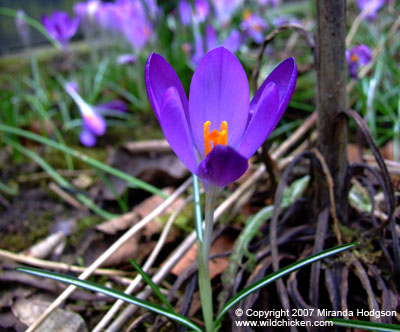

Crocus tommasinianus (also called early crocus)
Crocus
tommasinianus
Hardy, deciduous early-flowering corm bearing flowers in shades of pale to rich purple. One of the first flowers to open in late winter, it is a welcome sight. Crocuses spread freely by seed and naturalise well in lawns, creating large patches. The only downside with Crocuses is that they tend to collapse in heavy rain.
Being pollen and nectar rich, they are attractive to early foraging bees and bumblebees.
The purple Crocus is less attractive to marauding house sparrows who often rip the yellow flowering type to pieces, though why they do it is not known. They do the same to yellow primroses and I once watched a sparrow nip off every single flower from a primrose plant and leave them lying on the ground.
Flowers in winter and early spring.
Habit - upright. H&S: up to 10cm
Stem - the stem is actually the flower tube, which is narrow, upright, usually white with a hint of very pale purple.
Leaves - narrow and linear, dark green and usually with a central silvery-white stripe.
Flowers - borne singly, goblet shaped, six petals joined at the base of the flower. The colour ranges from pale to rich purple, occasionally white and sometimes paler on the outside of the petals. The stamens are a rich yellow-orange and heavy with pollen.
All aspects.
Any well-drained, moderately fertile soil.
Hardy.
Clumps may need thinning after a few years, which can be done in spring after flowering has finished.
May be attacked by squirrels or rodents, who eat the corms. Generally disease free but stored bulbs are vulnerable to rot.
They self seed readily and will spread by themselves, but you can collect and sow seed in a cold frame as soon as it is ripe, or pot up cormlets when the plant is dormant.
Garden Plant Information list of plant care info by botanical name